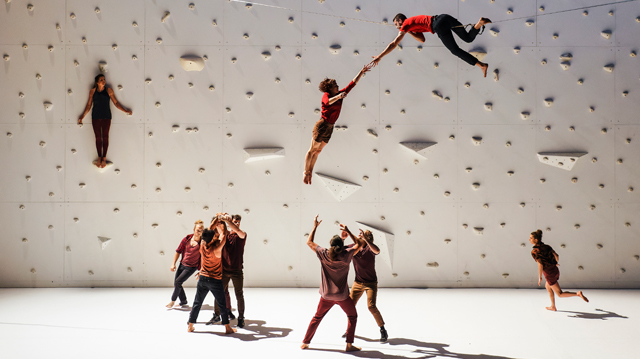
By Lina Mazioui
French-Algerian choreographer Rachid Ouramdane made his debut at the Brooklyn Academy of Music with his aerial dance piece, “Corps Extrêmes,” for BAM’s 40th Next Wave Festival on Oct. 27.
The festival is all about pushing limits and unfathomable heights that have never been reached before. The most outlandish ideas are welcomed, and convention is shunned. The Next Wave shines a light on the future of the arts, showcasing the most groundbreaking, or perhaps in this case, atmosphere-tearing performances. Through projected video, rock climbing, tightrope walking, and soaring dance, “Corps Extrêmes” explores the tranquility that comes with adrenaline and risk, and the desire of the land-confined human to fly away.
“Corps Extrêmes” means “extreme bodies” in French, and what a fitting title it is. The divergent dance piece features eight acrobats, a highliner, and a climber, all of whom push their bodies to the extreme. In their daily lives, they move and traverse in ways a human was not created for, but this rebellion against nature is the very trait that makes one inherently human.
The human spirit is fueled by breakthroughs and innovation, always looking for the extremes that will fulfill the ever-hungry soul. Though all of humanity is bound to traveling on Earth, it has found ways to sail on the sea and soar through the skies. It is always reaching, over and over again, higher and higher. The dance piece encapsulates that intense and innate human desire as the dancers and athletes take flight on stage, exemplified by the act of Nathan Paulin.
As the lights of the Howard Gilman Opera House dimmed, a rock climbing wall with a tightrope hanging across the stage was illuminated. A video projected onto the wall, filmed by videographer Jean-Camille Goimard, and a canyon made its way into the shot. The moving image was presented from a bird’s-eye view, giving the audience the heart-sinking feeling of being at such an enormous height. The heart sinks lower, and the engagement higher, as Paulin tiptoed across a tightrope, both in the video and on the stage as he entered from the side.
His voice rang from the speakers, explaining both the thrill and peace that comes from bringing his body to such unbelievable heights. Every step he took on the tightrope was accompanied by sentimental words that radiated from his heart as he pursued his passion. In the video, he spoke about how, surprisingly, the wind aids him as he walks the line. The echoes of water running and birds chirping could be heard, supplementing Paulin’s intentional and balanced movements on stage. Sometimes, he sat or laid down and closed his eyes. Despite his dangerous position, he was at peace.
This moment of individual tranquility was broken when the video stopped, and Paulin looked behind him to find the nine other members of the show appearing from over the climbing wall. They climbed over and scattered over the ledges and protrusions, making random movements that were simultaneously in harmony with one another. Once they reached the floor of the stage, the real show began.
The music, composed by Jean-Baptiste Julien, changed from peaceful to slightly more upbeat as the dancers got on each other’s heads, totems of three humans emerging from their movements. They walked around in this composition as Paulin continued his performance above them. As Paulin’s moves were predictable at this point, the focus shifted to those on the ground.
The dancers broke from their previous stances and went back to the wall, jumping from ledge to ledge, sometimes jumping off while another person awaited at the bottom to catch them. The performers ran around frantically and the music became intense as they seemingly searched for their next adrenaline-inducing task. They were desperate for risk and aimed to escape their mundane human experience.
A passionate desire took over the performers, and they looked to each other for fulfillment. In their fervor, they took to the skies, jumping from the hands of their companions who so eagerly propelled them to greater heights. In an act of desperation, each performer took turns jumping from the knees and hands of two other dancers to reach for Paulin, who was looking down at them. This scene was reminiscent of Michelangelo’s “Creation of Adam,” which illustrates the moment in the Bible where God gives life to the first human, Adam. Adam reaches to God, and their fingers are just almost touching. The choreography is a testament to the divine feeling the performers and athletes derive from their work. This process repeated, but they could never reach Paulin. This demonstrated that however hard an artist works, however far they push themselves, they will never be satisfied; they will never achieve perfection.
Finally, in some kind of revelation, the performers came together to create steps with their bodies, and acrobat Airelle Caen trod on those fragile steps to reach her hand towards Paulin. Paulin now understood that he, too, must reach her, so he laid his body upside down from the tightrope in order to allow himself to be grabbed. Their hands clasped together, and Caen’s weight was no longer supported by those below her. She hung from Paulin’s arms and twirled like a decorative ornament. In this moment of peace, the score quieted down; the previous excitement seemed like a fever dream. After having their heads in the clouds, both the performers and the audience were brought back down to earth.
The state of a feverish dream is not unlike that of which the dancers and athletes experience in their field. The complexity and passion of someone who pushes their body to the absolute limit is unlike any other. Ouremdane’s choreography is the closest thing to a tangible embodiment of that dream-like state. With “Corps Extrêmes,” the Next Wave was taken to a new height.
